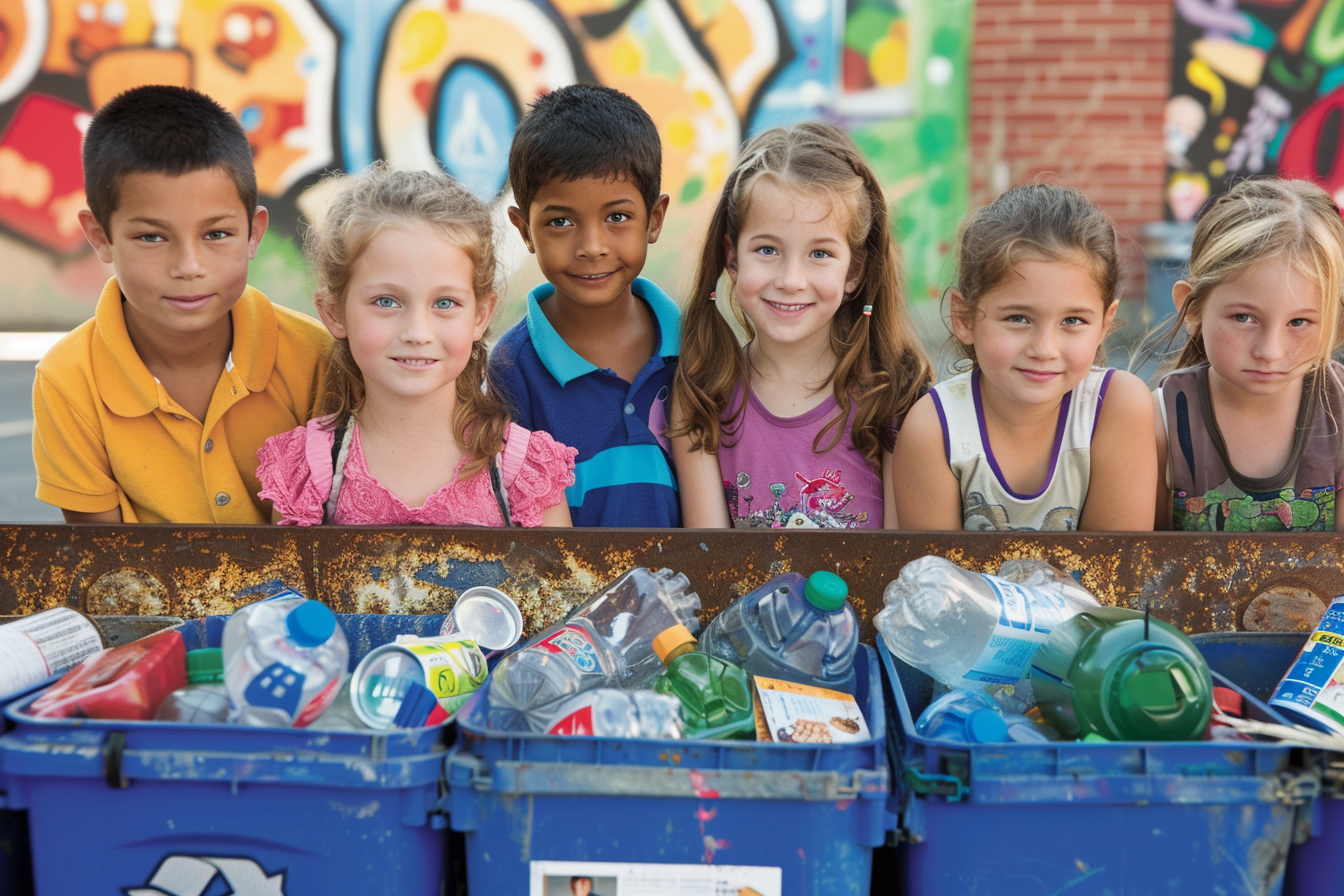Eco-Schools: Integrating Sustainability into Education
Discover how eco-schools weave sustainability, outdoor learning, and community action into daily education.

Imagine a school where students not only learn about the environment but actively engage in sustainable practices every day. Eco-schools are turning this vision into reality by integrating sustainability into the core of their educational approach. These innovative schools prioritize environmental stewardship, hands-on learning, and community involvement, creating a dynamic and engaging learning experience for students.
As the world grapples with pressing environmental issues, the need for eco-conscious education has never been greater. Eco-schools offer a unique solution by transforming traditional learning environments into hubs of sustainability and environmental awareness. From green buildings and outdoor classrooms to school gardens and energy-efficient practices, eco-schools provide students with the knowledge and skills needed to become responsible stewards of the planet.
We will explore the principles and benefits of eco-schools, examine various models, and offer practical tips for implementing eco-friendly initiatives. Join us as we delve into how eco-schools are shaping the future of education and empowering the next generation of environmental leaders.
Understanding Eco-Schools
Eco-schools are educational institutions that integrate sustainability into their core operations and curriculum. These schools focus on fostering environmental stewardship, promoting sustainable practices, and involving the entire school community in eco-friendly initiatives. The goal is to create a learning environment that not only educates students about environmental issues but also actively engages them in sustainable practices.
The concept of eco-schools has evolved over the years, gaining traction as awareness of environmental issues has grown. Originating from grassroots movements, eco-schools now form part of global networks that share resources and best practices. These schools emphasize the importance of hands-on learning, community involvement, and real-world applications of sustainability principles.
Enjoy science fiction? Check out my space books HERE on Amazon!
Core principles of eco-schools include reducing environmental impact, enhancing environmental literacy, and promoting health and well-being through sustainable practices. By adopting these principles, eco-schools aim to prepare students to be environmentally conscious citizens who can contribute positively to their communities and the planet.
Types of Eco-Schools
Eco-schools come in various forms, each with unique characteristics and benefits. Here are some common types of eco-schools:
- Green School Buildings: These schools are designed with eco-friendly architecture and sustainable resources, such as solar panels, rainwater harvesting systems, and energy-efficient lighting. The design minimizes the environmental impact and provides a healthy learning environment.
- Outdoor Classrooms: Utilizing natural settings for regular classroom activities, these schools incorporate outdoor learning spaces to connect students with nature. Outdoor classrooms can include forests, gardens, and nature trails, promoting hands-on learning and environmental awareness.
- School Gardens: Integrating gardening and agricultural education into the curriculum, school gardens teach students about food production, ecosystems, and sustainability. Students gain practical experience in growing plants, composting, and understanding the food cycle.
- Energy-Efficient Schools: Implementing renewable energy sources and energy-saving practices, these schools focus on reducing their carbon footprint. They may use solar panels, wind turbines, and energy-efficient appliances to conserve energy and educate students about renewable energy.
- Waste Reduction Programs: These initiatives focus on recycling, composting, and reducing waste. Schools educate students on the importance of waste management and involve them in projects to minimize waste production and promote recycling.
By exploring these types of eco-schools, educators and communities can find models that best fit their sustainability goals.
Benefits of Eco-Schools
Eco-schools offer numerous advantages that make them an appealing option for many families and educators. Here are some key benefits:
- Environmental Awareness: Teaching students the importance of sustainability and environmental stewardship helps them become responsible citizens.
- Hands-On Learning: Providing practical, real-world experiences through gardening, outdoor classrooms, and energy projects enhances student engagement and understanding.
- Community Engagement: Fostering relationships with local organizations and communities strengthens the school's impact and creates a network of support.
- Health and Wellbeing: Promoting healthy lifestyles and well-being through outdoor activities and sustainable practices benefits students' physical and mental health.
- Cost Savings: Reducing operational costs through energy and waste management allows schools to allocate resources more effectively.
These benefits highlight the potential of eco-schools to create a more sustainable and engaging educational experience for students. By understanding these advantages, educators and communities can better appreciate the value of eco-schools in fostering student success and environmental responsibility.
Implementing Eco-School Initiatives
Implementing eco-school initiatives requires careful planning and collaboration. The first step is developing a clear vision and plan for eco-friendly projects, which includes defining goals, identifying resources, and setting timelines. Involving educators, students, parents, and community members in this process ensures that the initiatives meet the needs and values of all stakeholders.
Curriculum integration is crucial. Incorporating sustainability topics into the existing curriculum helps students understand the importance of environmental stewardship. This can be done through interdisciplinary projects, science experiments, and hands-on activities that promote eco-friendly practices.
Teacher training and professional development are vital for the success of eco-schools. Ensuring that educators are equipped to teach sustainability and implement eco-initiatives is essential. Providing ongoing training and resources helps teachers stay updated with best practices and new approaches.
Student involvement is key. Encouraging students to take an active role in planning and executing eco-projects fosters a sense of ownership and responsibility. This can include roles such as eco-representatives, project leaders, and ambassadors for sustainability.
Community partnerships provide valuable support and resources. Collaborating with local businesses, environmental organizations, and government agencies can enhance the school's initiatives and create a broader impact. These partnerships can offer expertise, funding, and materials that support the school's sustainability goals.
Overcoming Challenges in Eco-Schools
Implementing eco-school initiatives comes with its own set of challenges, but these can be effectively managed with strategic planning and collaboration. One major challenge is securing funding and resources. Finding financial support through grants, donations, and community partnerships can help sustain the school's eco-projects.
Changing mindsets and encouraging a culture of sustainability can also be challenging. Addressing resistance to new practices requires clear communication about the benefits of eco-initiatives and involving all stakeholders in the process. Providing education and training can help shift perspectives and build support.
Balancing curriculum demands is another challenge. Integrating sustainability topics without compromising core academic subjects requires careful planning and creativity. Developing interdisciplinary projects that combine environmental education with other subjects can help achieve this balance.
Measuring the impact of eco-initiatives is crucial for their success. Establishing clear metrics and regularly assessing progress helps ensure that the initiatives are effective and allows for adjustments as needed. This continuous evaluation can demonstrate the value of eco-schools and guide future improvements.
Case Studies
Implementing eco-school initiatives has led to notable successes in various educational settings across the country. Here are three case studies highlighting the impact of these methods:
Case Study 1: Green School Building in Washington
A school in Washington was designed with eco-friendly architecture, including solar panels, rainwater harvesting systems, and energy-efficient lighting. The school reduced its carbon footprint and operational costs while providing a healthy and inspiring learning environment. Students actively participated in maintaining the green infrastructure, gaining valuable knowledge about sustainable living.
Case Study 2: Outdoor Classroom in Vermont
A school in Vermont created outdoor classrooms in forested areas and gardens. Students regularly engaged in hands-on learning activities such as planting, composting, and studying local wildlife. This approach enhanced student engagement and environmental awareness, with many students expressing a deeper connection to nature and a greater understanding of ecological principles.
Case Study 3: School Garden Project in Illinois
An Illinois school integrated a garden project into its curriculum, where students learned about food production, ecosystems, and sustainability. The garden provided fresh produce for the school cafeteria and served as a living laboratory for science classes. The project fostered a sense of community, with parents and local organizations contributing resources and expertise. The garden became a hub for hands-on learning and environmental education.
Practical Tips for Educators and Administrators
Implementing eco-school initiatives can be straightforward with the right approach. Here are some practical tips for educators and administrators to consider:
- Start Small: Begin with manageable projects and expand over time. Small initiatives can build momentum and demonstrate success.
- Involve Students: Engage students in planning and implementing eco-initiatives. Their enthusiasm and creativity can drive projects forward.
- Leverage Community Resources: Utilize local expertise and resources to enhance learning experiences and reduce costs.
- Integrate Across Subjects: Include sustainability topics in various subjects to provide a holistic understanding.
- Celebrate Successes: Recognize and celebrate achievements to build momentum and encourage ongoing participation.
These tips can help educators and administrators create a successful and sustainable eco-school that benefits students and the environment.
Future Trends in Eco-Schools
The future of eco-schools is evolving, with new trends enhancing their effectiveness and reach. Advanced renewable energy technologies, such as solar panels and wind turbines, are becoming more accessible and affordable. Implementing these technologies can further reduce schools' carbon footprints and provide valuable learning opportunities for students.
Smart school buildings utilizing technology to enhance sustainability efforts are also on the rise. These buildings can monitor energy usage, optimize lighting and heating, and manage resources more efficiently.
Check out our engaging printable posters. CLICK HERE to explore!
Global collaboration is another emerging trend. Connecting with eco-schools worldwide for shared learning and projects can broaden students' perspectives and foster global awareness.
Sustainable food practices, such as integrating local and sustainable food sources into school meals, are gaining popularity. These practices promote health, support local economies, and reduce environmental impact.
By staying updated with these trends, eco-schools can continue to innovate and provide high-quality, sustainable education for students.
Conclusion
Eco-schools represent a transformative approach to education, integrating sustainability into everyday learning and fostering environmentally conscious students. By implementing green school buildings, outdoor classrooms, school gardens, and energy-efficient practices, these schools provide hands-on learning experiences that engage students and promote environmental stewardship. The benefits of eco-schools, such as enhanced student engagement, community involvement, and cost savings, highlight their potential to create a more sustainable and effective educational environment.
As the demand for sustainable practices grows, eco-schools are well-positioned to lead the way in environmental education. By overcoming challenges such as funding, changing mindsets, and balancing curriculum demands, schools can successfully implement eco-friendly initiatives. Embracing future trends like advanced renewable energy technologies, smart school buildings, and global collaboration will further enhance the impact of eco-schools. By fostering a culture of sustainability, eco-schools can prepare students to be proactive, informed citizens who are committed to making a positive difference in their communities and the planet.
Check out some of my latest science fiction books HERE on Amazon!
Transform your classroom into an inspiring and vibrant learning space with our beautifully designed printable posters! Perfect for engaging your students and enhancing your teaching environment, our poster bundles cover everything from historical philosophers to animals. CLICK HERE to explore our exclusive collections on Teachers Pay Teachers and give your students the motivational boost they need!
